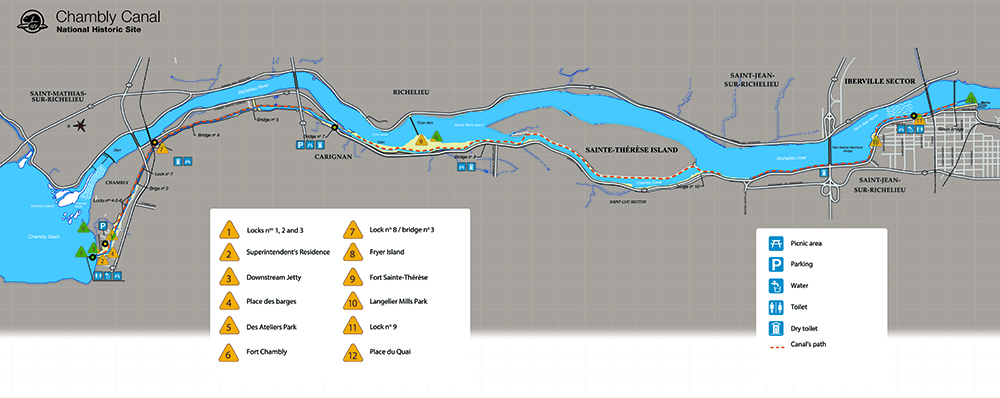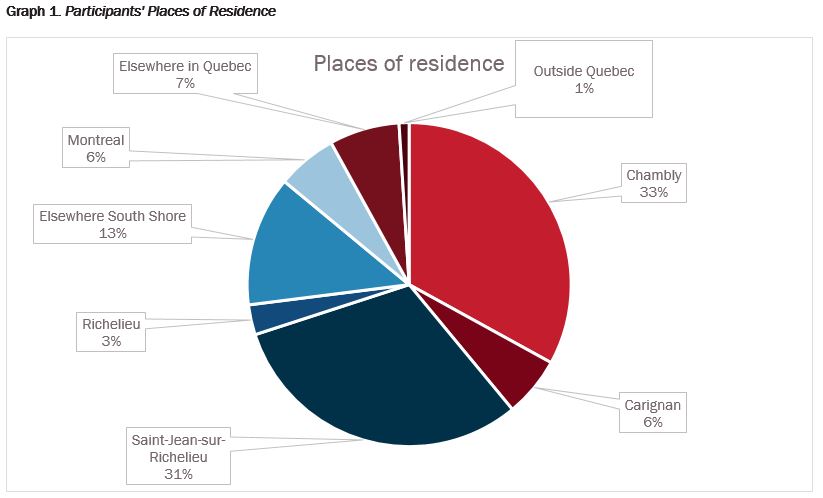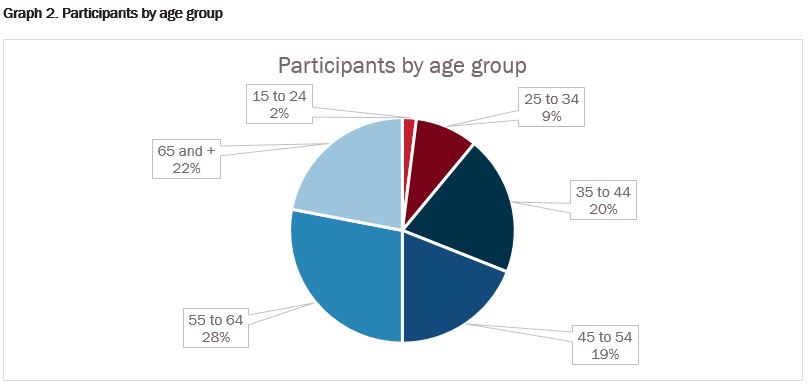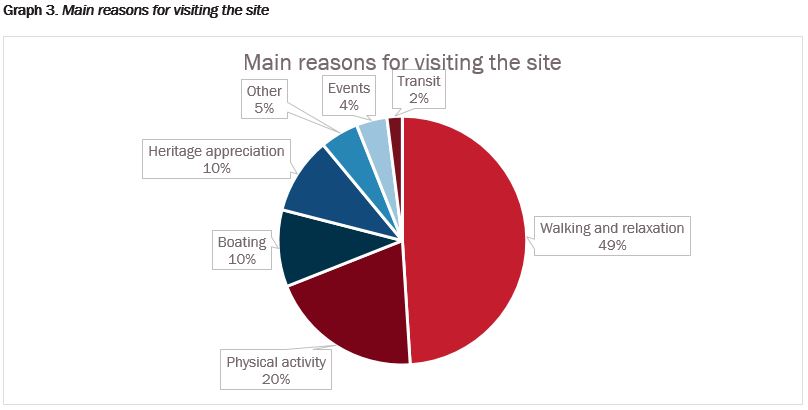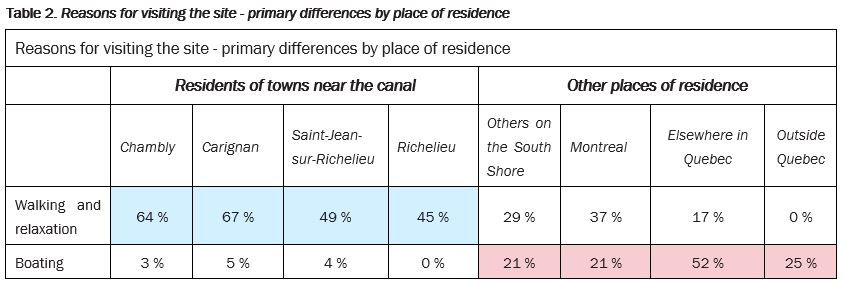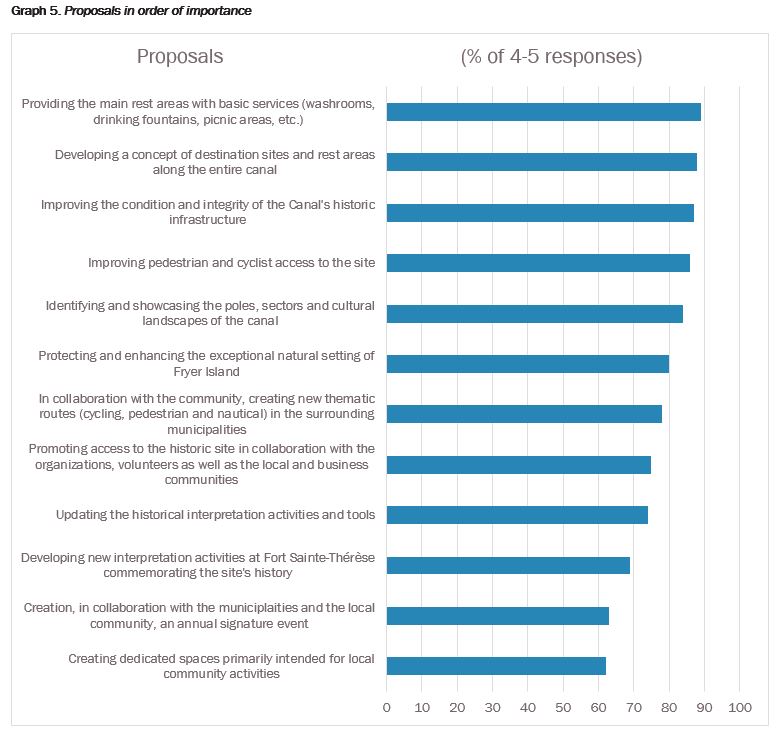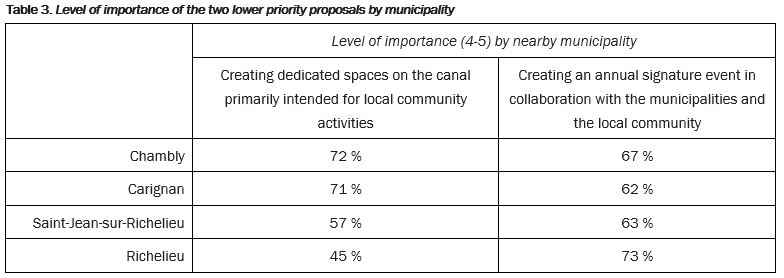
Report of the consultation on the draft management plan
Chambly Canal National Historic Site
End of the consultation period on the draft management plan
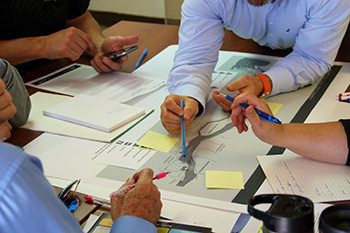
The consultation period for the draft management plan is now over. A report presenting the highlights of the consultation activities will be available shortly.
In November 2017, Parks Canada presented a draft management plan for the future of the Chambly Canal and invited the public to comment on this proposal throughout the month.
In addition to the online forms that have gathered hundreds of comments, a public meeting was held on November 22 with visitors, residents of adjacent neighbourhoods, partners and organizations interested in the management and operation of this national historic site.
If you have any questions, please contact us at UVNQ.communications@pc.gc.ca.
Report of the consultation on the draft management plan for the Chambly Canal National Historic Site
Prepared bu Hill+Knowlton Stratégies
The report is also available in PDF. (430Ko)
Table of content
- Context
1.1. Chambly Canal National Historic Site
1.2. H+K Strategies’ mandate
-
Consultation process
2.1. Consultation Activities
2.2. Promotion Of Activities
2.3. Collection Of Opinions And Comments
-
Analysis of results
3.1. Profile Of Respondents To The Questionnaire
3.2. Level Of Agreement With The Proposed Vision
3.3. Level Of Importance Attributed To The Proposals Of The Draft Management Plan
3.4. Analysis Of Additional Comments
-
Findings relating to the proposed management plan
4.1. Strategy 1: The Chambly Canal – Heritage, Surroundings And Cultural Landscapes To Preserve And Enhance
4.2. Strategy 2: An Improved And Diversified Visitor Experience From One End Of The Canal To The Other
4.3. Strategy 3: A Source Of Pride And Benefits For The Community
4.4. A Targeted Approach For Fort Sainte-Thérèse
-
Conclusion and next steps
5.1. Conclusion
5.2. Next steps
1. Context
1.1 Chambly Canal National Historic Site
Located in the heart of the Montérégie region, the Chambly Canal is part of a network of five historic canals in Quebec managed by Parks Canada. Its waterway connects the cities of Chambly and St.-Jean-sur-Richelieu while passing through the municipalities of Carignan and Richelieu. Historically, the canal contributed to the economic growth of the city of Chambly and in particular to that of St.-Jean-sur-Richelieu, which was a hub of maritime, road and rail transport in the 19th century. The canal also contains the remnants of Fort Sainte-Thérèse as well as other cultural resources that bear witness to the wealth of its history.
Today, in addition to the nearly twenty-kilometre-long waterway which allows vessels to bypass the Richelieu River rapids while passing through a diversity of landscapes, the canal offers a multifunctional trail located on the old towpath. In 2017, nearly 260,000 people frequented the site and 1,700 boats passed through its locks.
Map 1. Chambly Canal National Historic Site
The Chambly Canal management plan is a strategic document that will guide the management and operation of the site over the next 10 to 15 years by formulating a vision for the future, as well as key strategies and objectives. Since the publication of the last management plan in 2007, the Chambly Canal has been in a state of constant transformation and significant investment in site infrastructure will be completed by 2020. In this context, the development of a new plan adapted to the challenges, opportunities and expectations of current visitors will enable the Chambly Canal National Historic Site to adapt to its evolving environment and aspire to reach its full potential, in line with its important historical value and place in the community.
1.1. H+K strategies’ mandate
Hill + Knowlton Strategies was commissioned by Parks Canada to develop and implement a public consultation process on the draft management plan for the Chambly Canal National Historic Site.
As part of this mandate, Hill + Knowlton Strategies was responsible for a number of tasks, including, among others, the development of tools used in the public activities, the facilitation of public meetings, and the writing of this report on the results of the consultation activities.s.
2. Consultation process
The draft management plan initially benefitted from a visioning exercise conducted in October 2016 with various community stakeholders. This exercise helped to establish a consensus on what the canal should be in 2035 and guide the development of the new plan. On November 6, 2017, Parks Canada announced it would be holding consultations on its draft management plan for the Chambly Canal and invited the population to participate.
The tools developed to collect comments and the consultation activities held as part of the public consultation process intended to maximize the participation of residents of adjacent towns, visitors, partners and organizations to gather comments on the proposals presented in the draft management plan.
2.1. Consultation activities
Two ways to participate in the consultation on the draft management plan were proposed in order to increase participation of visitors, residents of the Richelieu Valley, and residents of the nearby towns.
On-line consultation
A website presenting the consultation process, www.consultationscanal.ca, was created to facilitate citizen participation. The backgrounder on the draft management plan, as well as information on the consultation activities was available on the website. From November 6 to December 3, 2017, visitors to the website could also complete the questionnaire used during the consultation sessions to identify their priorities among the items proposed in the plan.
Consultation meetings of stakeholders and the public
Two consultation meetings were held on November 22, 2017. The first was held in the afternoon with about thirty representatives of different stakeholders and interest groups. The second meeting, which was open to the general public, took place in the evening and attracted about 25 people. Each meeting included a presentation of the draft management plan as well as a short question and answer period. Participants were then invited to discuss the draft management plan in a round-table session, guided by a series of questions, and to report the highlights of their discussions during the plenary session. Finally, participants could also complete the questionnaire designed to identify priorities among the items proposed.
2.2 Promotion of activities
Information on the consultation activities was communicated by different means. First, a press release announcing the approach was published on November 6, 2017 and follow-up phone calls were made to local media. Information on the consultation was also put online and shared on Parks Canada's social media (Facebook and Twitter). Paid publications in social media were also used to expand the reach of messages. Finally, posters announcing the consultation and inviting the public to visit the website to participate were displayed in various public places located in municipalities near the canal (e.g. city halls, libraries).
2.3. Collection of opinions and comments
A questionnaire was developed to collect feedback on the draft management plan. This questionnaire was used in all of the consultation activities, in person and online. The questionnaire focused on the assessment of the vision and the objectives contained in the draft management plan and included space for additional comments.
Out of a total of 375 questionnaires completed between November 6 and December 3, 2017, 87% had complete responses. The results presented in the following section of the report are calculated based on the total number of responses for each question, as opposed to the total number of questionnaires.
In addition, about 50% of the participants who filled out a questionnaire left additional comments in the space provided for this purpose.
Activity and number of completed questionnaires
Consultation meetings with stakeholders and the public : 28 questionnaires
On-line consultation : 347 questionnaires
Total : 375 questionnaires
3. Analysis of results
3.1. Profile of questionnaire respondents
Place of residence
The place of residence of respondents was analyzed based on the postal codes provided in the questionnaire. These can be divided according to the following categories of residence: the four cities near the canal, i.e., Chambly, Carignan, Richelieu and Saint-Jean-sur-Richelieu; elsewhere on the South Shore; elsewhere in Quebec (including Montreal); or, outside Quebec. About two thirds of the consultation participants live in Chambly or Saint-Jean-sur-Richelieu.
Age groups
People from all age groups completed the questionnaire. The most represented group was the 55-64 age group.
Main reasons for visiting the site
Among the many answers to the question regarding the primary motivation for visiting the site, the most frequent response was "walking and relaxation"' (49%), followed by "physical activity" (20%).
However, the main reason for visiting the site is different for people living nearby compared to those who live elsewhere. In fact, the majority of people living in one of the four towns located near the canal indicated that they use the canal mainly as a place for walking and relaxation. Conversely, individuals living elsewhere on the South Shore, in Montreal, Quebec City or outside the province, indicated a higher rate of use of the canal for boating than the residents of towns located near the canal.
3.2. Level of agreement with the proposed vision
94% of respondents "agree" or "completely agree" with the proposed vision for the future Chambly Canal, described as follows in the information document:
- Preserve and promote the heritage, surroundings and cultural landscape of the Chambly Canal;
- Improve and diversify the visitor experience from one end of the canal to the other;
- Make the Chambly Canal a source of pride and economic benefits for the local community.
3.3. Level of importance attributed to the proposals of the draft management plan
Participants indicated the level of importance they attributed to twelve proposals related to the objectives for the site on a scale of 1 to 5 (5 being "very important" and 1 being "very unimportant"). In the following graph, the proposals are presented in order of importance according to the percentage of respondents who indicated the proposal was 'important' (4) or 'very important' (5).
According to the respondents, the most important proposals are those that target improvements to infrastructure, and to physical integrity of the historical and natural attributes of the canal, as well as to site services and access to the site.
The following two proposals were considered less important, while still receiving support from more than 60% of participants:
- Creating an annual signature event in collaboration with the municipalities and the local community (63%);
- Creating dedicated spaces on the canal primarily intended for local community activities (62%).
Since these two proposals primarily involve the local community, an analysis of the responses provided by the residents of the four municipalities located near the canal was conducted. This analysis shows that 72% of the respondents living in Chambly consider the proposal to create dedicated spaces for local community activities to be important compared to only 57 % of respondents residing in St-Jean-sur-Richelieu, indicating a discrepancy of opinions among residents living near the canal. This difference is even more revealing in that these two groups of residents represent a similar percentage of consultation participants. On the other hand, the creation of an annual signature event has a more constant level of importance among residents living near the canal, with stronger support from the residents of Chambly and Richelieu.
There are fewer differences among residents near the canal regarding the other proposals, which are considered more important. In addition, the residents of nearby towns generally express greater support for the proposals compared to people living in Montreal, elsewhere in Quebec or outside of Quebec, for whom support is more variable. It is also interesting to note that participants who live elsewhere on the South Shore show similar levels of appreciation for the proposals as the residents of nearby municipalities.
In particular, participants who live in Montreal or elsewhere in Quebec strongly support the proposals to improve the condition and integrity of the historical infrastructure, to promote the poles, sectors and cultural landscapes of the canal and to create new thematic routes on the site. These same participants accord less importance to the development of the Fort Sainte-Thérèse and Fryer Island sites as well as to proposals for enhancing site activities in collaboration with neighbouring communities, such as the creation of an annual signature event.
In conclusion, it appears that for most respondents, 60 % of whom live near the site, the priorities for the future of the canal should be the improvement of the canal’s physical integrity and of the basic services provided, as well as the development of its existing assets. New development that corresponds to these priorities, such as the creation of rest areas and of new heritage interpretation tools for the site also received significant support. Compared to these proposals, the creation of an annual signature event and the creation of community activity spaces are considered less important, while still receiving a favourable response from participants.
3.4. Analysis of additional comments
All the comments received were analyzed, including those collected in the questionnaires as well as those expressed during discussions at the meetings on November 22, 2017. Several recurring themes emerged from this analysis.
Preserve and promote the canal's existing assets
In light of the comments received, there is a consensus on the importance of prioritizing investments in the physical integrity and the existing assets of the canal, as proposed by strategy 1 of the plan. Several comments concerning the need to maintain the buildings (e.g., superintendent's house) and infrastructure along the canal (e.g., bridges, dams) were raised during the in-person and online activities. Others would like to see the historical and archaeological elements of the site enhanced.
In addition, several respondents stressed the need to continue to protect the environment, biodiversity and wildlife. Among the most cited elements were the stabilization and maintenance of the banks of the canal, particularly in response to the threat of erosion, and the sound management of the vegetation along the canal. Furthermore, many participants indicated their interest in the enhancement of the site through information panels on the history, infrastructure and biodiversity of the canal. However, a number of respondents mentioned the need to pay special attention to the risk that increased development of the site could generate a significant increase in site traffic, which could in turn interfere with conservation of the natural environment. The preservation and development of the site's assets, including its natural environment, are therefore priorities shared by Parks Canada and the participants.
"It would be nice to restore the Superintendent's House and make it accessible to the public. It's a beautiful building in an excellent location that isn't being used!" (Free translation)
« Ce serait bien de réhabiliter la maison du Surintendant et de la rendre accessible au public. C'est un beau bâtiment très bien situé qui ne sert pas ! » (Original citation)
"I believe that [the site] is an important historic site. However, I am against development that would affect the site’s natural environment." (Free translation)
« Je crois que [le site] c'est un lieu historique important. Par contre, je suis contre du développement qui affecterait le cadre naturel du site. » (Original citation)
Preserve the nature of the Canal
A number of participants commented on the importance of preserving the natural character of the canal and especially the green spaces found along the canal. Many who frequent the site to observe the fauna and flora consider it to be a large natural park. Several comments relate to the creation of green spaces and the planting of trees, especially fruit trees and shrubs. It is therefore hoped that the development of the canal and activities on site will not be at the expense of the site’s natural character. Moreover, many people highlighted the need to keep the atmosphere of the site calm and quiet to encourage its use as a green space for relaxation. The importance of not scheduling too many events at the site in order to maintain the balance between visitors, tourists, and local users was also emphasized at the June 19 discussion groups. In addition, improving the quality of water in the canal to be able to use it for swimming is also desired by certain users.
"It would be important to leave more room for green spaces. The city is increasingly being built up and the Canal is one of the few places where there are still green spaces." (Free translation)
"Il serait important de laisser une plus grande place aux espaces verts. La ville est de plus en plus construite et le canal est l’un des rares lieux où il y a encore des espaces verts." (Original citation)
"The Lachine Canal is, among other things, a delicate strip of wilderness in an urban area. This is its greatest asset. We see along the canal all sorts of wildlife: turtles, frogs, song birds, herons, kestrels, cormorants, ducks, red-wing blackbirds and more. Whatever your plans to develop the canal, you should, in my opinion, give the highest priority to the preservation and health of the ecosystem."
Review the multifunctional path and the offer of boating services
For many participants, the existing Chambly Canal services and facilities should be improved in order to consolidate the recreational vocation of the site, as proposed by strategy 2. In particular, many participants suggested reviewing the layout of the multifunctional path to make it safer and more comfortable. However, others fear that a change in the path surface (i.e. paving the path) will lead to an increase in path use by cyclists and increase their speed, in turn increasing safety issues for path users. These safety issues concern primarily the cohabitation of cyclists and pedestrians as well as the presence of motor vehicles on the path, which are not allowed. In addition to taking cohabitation into account in any future change to the path, a number of comments expressed the desire to avoid "denaturing" the site’s character through improvements to the path.
As for boating, several comments stressed the importance of increasing the services offered to boaters to increase their use of the canal, such as adding electricity to mooring sites or promoting the restaurants located nearby. The relevance of establishing a schedule of the raising of bridges over the canal to better allow boaters to enjoy the cities where they stop and to help users of the site and nearby residents to better plan their trip was also noted. The extension of the boating season on the canal, as well as the addition of water activities (e.g.: kayaking, fishing) were also of interest to citizens and stakeholders.
"In order to modernize the bike path (Route Verte), to make it safer, more pleasant, cleaner and easier to maintain, it would be high time to pave the path." (Free translation)
« Afin de mettre à jour la piste cyclable (Route verte), de la rendre plus sécuritaire, agréable, propre et facile d'entretien, il serait grandement temps de paver de bitume la piste. » (Original citation)
"The waterfront must be made inviting for boaters (tourists) to make them want to get off their boats from time to time to visit. Docks, terraces, restaurants, but all while preserving nature and the large green areas. The historical side must not be denatured, but the site must be welcoming and accessible." (Free translation)
« Il faut rendre le bord de l'eau invitant pour les plaisanciers (touristes), leur donner envie de descendre de leurs bateaux à l'occasion pour visiter. Des quais, des terrasses, des restos, mais tout en préservant la nature et les grands espaces verts. Il ne faut pas dénaturer le côté historique, mais il faut être accueillant et accessible. » (Original citation)
Improve site accessibility and the visitor experience
Several comments received relate to the accessibility of the site and the visitor experience, elements targeted by strategy 2. For many, the accessibility of the site and services, particularly for people with reduced mobility, needs improvement. Other comments mention increasing the accessibility of footbridges for cyclists and pedestrians, or adding parking near the site's attractions.
Concerning the renewal of the visitor experience, many comments concern the addition of services along the canal, such as shaded areas for cyclists and walkers, toilets, water fountains, food service facilities, picnic tables or playgrounds for children. Several participants suggested adding lighting along the multifunctional path and in the parks to allow users to enjoy the site for longer time periods.
Other comments concerned the development of meeting places for activities such as exhibitions and shows, or even a public market. Finally, proposals on how to improve the tourist offer at the canal and especially at Fort Sainte-Thérèse were made, ranging from information panels to activities to guided or self-guided interpretation tours.
“I would love to see the canal preserved and updated. I agree with adding rest areas including drinking fountains and washrooms […] I also think that adding a few access points or foot bridges would help to make the site more accessible. A small parking area close to these access points would also be appreciated.” (Free translation)
“J’aimerais bien voir le canal préservé et actualisé. Je suis d’accord avec l’ajout de haltes incluant des fontaines et des toilettes […] Je pense également que l’ajout de quelques points d’accès ou de passerelles aiderait à rendre le site plus accessible. Un petit stationnement à proximité de ces points d’accès serait également apprécié. » (Original citation)
Review the communication methods and build on collaboration with stakeholders
Participants underlined the need to improve communication and consultation with the community, including with the organizations and actors involved in the development of the canal as well as for the promotion of the canal and its surroundings. More specifically, stakeholders mentioned the need to communicate more systematically with the various users of the site and more closely with local and tourist organizations to inform them of activities or work planned for the site. On a number of occasions, it was suggested that a consultative body be created to bring together all the partners of the canal, a proposal that generated strong support from stakeholders.
With respect to strategy 3, it was repeatedly mentioned that the canal is a vector of economic development and that activities with the potential to attract tourists for longer stays should be promoted. In this sense, the stakeholders consulted showed a great willingness to collaborate actively in the development and activities of the canal.
"The most important thing is to create opportunities for interaction and consultation with all the organizations (the 4 towns, the businesses and the organizations)." (Free translation)
« L’important, c’est de créer des occasions d’échange et de concertation avec l’ensemble des organisations (les 4 villes, les entreprises et organismes). » (Original citation)
4. Findings relating to the proposed management plan
In general, analysis of the questionnaire results and comments received confirms support for the strategies proposed in the Chambly Canal National Historic Site draft management plan. This support for the draft management plan is also expressed by the fact that 94% of questionnaire respondents "agree" or "completely agree" with the proposed vision for the Chambly Canal of tomorrow. This section presents an analysis of the assessment of the management plan strategies based on participant feedback.
4.1. Strategy 1: the Chambly Canal – heritage, surroundings and cultural landscapes to preserve and enhance
Strategy 1 received significant support from participants. The two main proposals of this strategy, i.e., to improve infrastructure integrity as well as the identification and development of the canal's components are considered important by 87% and 84% of respondents respectively. In addition, a significant number of questionnaires and public meetings comments underlined the importance of preserving and promoting the canal's assets before beginning any other site interventions. In addition to the infrastructure and heritage buildings, many participants indicated the importance of adding preservation of the site’s natural character to the items targeted by this strategy. The consultation thus revealed a strong consensus on the importance of this strategy as a pillar of the management plan as well as the importance of preserving the site's natural environment.
4.2. Strategy 2: an improved and diversified visitor experience from one end of the canal to the other
The proposals arising from strategy 2 received strong support from participants, many of whom use the site primarily for walking and relaxation as well as for physical activity. In particular, the proposals to create rest areas and provide them with basic services were very well received by participants. This support is expressed by the significant levels of importance accorded to these proposals, 88% and 89% respectively, and by the many positive comments expressed on this subject by participants in the online activities and in person. Also, improvement to site access for pedestrians and cyclists was considered important by 86% of the participants and was the subject of many comments, including the need to improve accessibility to the site for people with reduced mobility. The other two proposals of the strategy, i.e., the creation of new thematic routes and the updating of the interpretation tools were very well received, with importance levels of 78% and 74%, respectively. Therefore, it can be stated that strategy 2 addresses desired improvements to the site visit experience.
4.3. Strategy 3: a source of pride and benefits for the community
Strategy 3, which aims to increase the engagement of the local community and their ownership in the Chambly Canal, was also well supported by respondents, however, was considered a lower priority than the other two strategies. The two proposals related to this strategy, the creation of dedicated spaces for community activities and the creation of an annual signature event, are considered less important than the other proposals. However, they are considered important by a majority of respondents, i.e., more than 60 %. Moreover, the importance of increasing dialogue and interactions with the local community was stressed repeatedly during the two meetings of November 22, 2017. Several comments received in person and online stressed the willingness of the local community to become more involved in the development of the canal, particularly in the promotion of attractions in the adjacent municipalities (e.g. shops and services nearby) and the recreational offer. Overall, the results of the consultation activities demonstrate the importance attributed to strategy 3 for a concerted development of the canal in the coming years.
4.4. A targeted approach for Fort Sainte-Thérèse
The targeted approach for Fort Sainte-Thérèse, located on Fryer Island, is supported by questionnaire responses as well as in participant comments. In particular, 80% of the respondents support the proposal to preserve and promote the unique natural environment of Fryer Island, and 69 % support the importance of developing new interpretation tools on the site of the fort. While only a small number of participant comments focused on the site of Fort Sainte-Thérèse, most of these comments emphasized the importance of preserving the site’s natural character, which is considered a unique feature. Other comments mentioned the importance of continuing to work on the vestiges of the fort and of improving site accessibility, but always from the perspective of not altering the nature of the site or creating too much site traffic. These responses thus support the approach proposed by Parks Canada of preserving the natural character of the site while still developing its commemoration potential and turning it into a place of interest.
5. Conclusion and next steps
5.1. Conclusion
The consultation activities held in person and online facilitated the participation of a large number of residents of the municipalities located near the canal as well as elsewhere in the region. Many participants had a good knowledge of the canal, since they frequent it often or live nearby. The consultation thus accessed a population that was well informed about the realities of the historic site.
The approach revealed a strong consensus (94%) supporting the vision proposed by Parks Canada upon which the management plan is based. This support, though somewhat nuanced, is also expressed for the different strategies proposed in the management plan.
For those who participated in the consultation, the preservation of the canal, including its physical integrity and its environment, the enhancement of its assets, including heritage components, and the improvement of the recreational services offered are of primary importance. There also seems to be a consensus on the importance of establishing a forum for better communication with the partners, organizations and other stakeholders interested in the canal in order to support the collaborative approach promoted by Parks Canada.
As mentioned above, among the findings that emerged from this process and which merit greater attention in the management plan are the preservation of green space as well as the willingness to strengthen communications between the Agency and the community, such as through a forum for exchanging information.
5.2. Next steps
The draft management plan will be finalized in the light of the comments expressed in this consultation and will then be submitted to the Minister of Environment and Climate Change and Minister Responsible for Parks Canada, the Honourable Catherine McKenna, by fall 2018. Once approved, the new management plan for the Chambly Canal National Historic Site will be published on the Parks Canada website. Its implementation will be subject to an ongoing dialogue to report on progress and adapt priorities over time.
